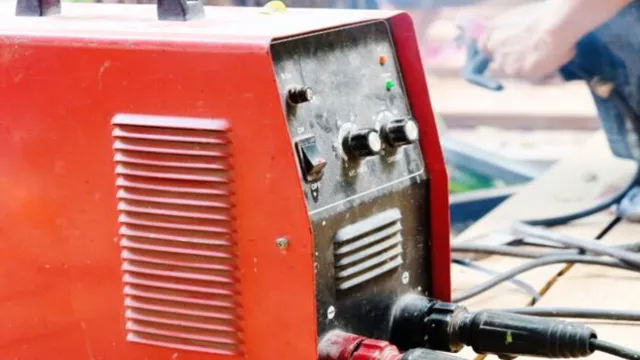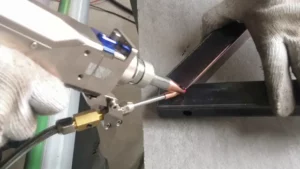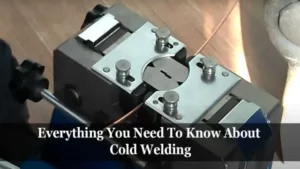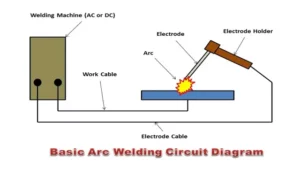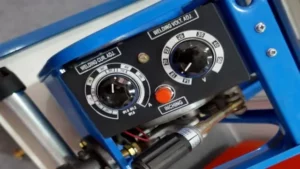Do you ever wonder how those shiny, metal structures are put together? Welding machines have been the backbone of many industries, allowing for the creation of strong and durable metal structures. But what exactly does a welding machine do? Essentially, a welding machine uses electricity to melt and fuse two metal pieces together. Just like glue, the melted metal acts as a bonding agent, creating a seamless connection between the two pieces.
This process is used in a variety of fields, ranging from construction to automotive manufacturing. Let’s take a closer look at the inner workings of a welding machine and how it functions.
Introduction
If you’ve ever wondered about the role of a welding machine, then you’re in the right place. A welding machine is a device that uses electricity to create heat and fuse two or more pieces of metal together. It’s a crucial tool in metal fabrication because it allows craftsmen to create structures that are both strong and durable while also being aesthetically pleasing.
Welding machines come in different types, depending on the specific type of welding technique that is required, with some being more suitable for thicker materials than others. Overall, a welding machine is an essential tool for anyone who needs to join metal pieces, from small DIY projects to large-scale construction work. By harnessing the power of electricity, a welding machine can deliver a clean and effective welding job that would be otherwise impossible to achieve manually.
Explanation of Welding Machines
Welding machines are used to join metals together and are commonly used in industries such as construction, automotive, and manufacturing. These machines work by using heat to melt the metals and joining them when they cool and solidify. There are different types of welding machines, including gas, arc, and laser welding machines, each with their own unique features and characteristics.
The type of welding machine used will depend on the specific material being welded, the required strength of the weld, and the skill level of the welder. Additionally, safety precautions must be taken when using welding machines due to the high temperatures and potential hazards involved. Understanding how welding machines work, their different types, and safety measures will contribute to efficient and safe use of these machines in various industries.

Types of Welding Machines
Welding machines are used in a range of industries, from construction to manufacturing, providing a versatile way to join metal components. Several types of welding machines are available, each suited to specific welding methods, materials, and working conditions. Choosing the right welding machine is essential for getting the job done efficiently and effectively.
Some of the most common types of welding machines include MIG (Metal Inert Gas), TIG (Tungsten Inert Gas), Stick welders, and Plasma cutters. MIG welding machines are ideal for welding thicker metals, while TIG welding machines provide high-quality, precise welds and are suitable for thinner materials. Stick welders are versatile and can be used in a variety of welding situations.
Plasma cutters, on the other hand, are used to cut through metal and are great for precision work. With so many options available, it’s essential to work with an experienced welder or to conduct thorough research when selecting the best welding machine for your needs.
How Does a Welding Machine Work?
A welding machine is a tool that is used to join two pieces of metal by melting them together with heat. The machine produces a high amount of heat, which can be controlled by the operator depending on the thickness and type of metal being welded. The basic principle behind welding is simple; when intense heat is applied to the metal, the molecules vibrate faster and eventually melt.
The melted metal from both the pieces being welded mix together and cool, forming a strong bond between the two. A welding machine generates electricity by either using a transformer or an inverter to convert the high voltage AC supply to a lower voltage DC supply. The DC power is then used to create an electric arc.
The electric arc melts the metal, and a filler material is used to seal the gap between the two pieces, creating a strong weld. The heat generated can be incredibly high, making it necessary to use protective gear like gloves, a welding helmet, and a welding apron. Welding machines can be used for a wide range of applications like construction, automotive, and manufacturing.
Power Source and Current
A welding machine is a complex piece of equipment that generates the heat necessary to melt metal and fuse it together. The power source and current are key components of a welding machine, as they provide the necessary energy to generate the heat. Welding machines typically use either AC or DC power, depending on the materials being welded and the specific type of welding process being used.
AC power is commonly used for welding materials such as aluminum or magnesium, while DC power is used for welding steel and other materials. The current is also important, as it determines the amount of heat that is generated. Welding machines typically have adjustable current settings, allowing the user to fine-tune the energy output to match the specific welding job at hand.
By understanding how the power source and current work together, welders can create strong, durable welds that will stand up to even the most demanding applications.
Electrodes and Filler Material
A welding machine works by fusing two or more metals together using heat. The machine is designed to generate an electrical arc that melts the metals at the point of contact. This process requires the use of electrodes and filler material.
The electrode is a metal conductor that comes into contact with the workpiece, allowing electricity to flow through it and generate the arc. Filler material is added to the joint to reinforce it and ensure the weld is strong. The type of electrode and filler material used will depend on the metals being joined and the desired outcome.
Welding machines can be powered by various sources, such as electricity, gas, or batteries. The key to a successful weld lies in the skill and experience of the welder. They must be able to control the temperature, maintain the correct distance, and apply the correct amount of pressure to create a strong and lasting bond.
Whether you’re welding steel, aluminum, or another metal, understanding the process and using the right tools and materials is crucial for achieving high-quality results.
Shielding Gas
Shielding Gas Welding is a process that involves the use of heat to join two or more pieces of metal or thermoplastics. The welding machine works by generating an electrical arc that melts the metal surfaces, fusing them together. But what happens to the metal in the vicinity of the arc, particularly at high temperatures where it is highly reactive? This is where shielding gas comes in.
Shielding gas is a type of gas that is used to protect the welding zone and its immediate vicinity from unwanted chemical reactions, especially oxidation and nitration. The gases used include carbon dioxide, argon, helium, nitrogen, and oxygen; each of which has a specific purpose depending on the welding type. For instance, carbon dioxide is ideal for deep penetration welding, while helium is used for high-temperature welding.
Argon is commonly used to protect the welding zone from atmospheric gases, preventing porosity in the weld bead. In summary, shielding gas is essential in welding because it provides a controlled environment that allows for high-quality, defect-free welds.
Benefits of Using a Welding Machine
A welding machine is a powerful tool that allows you to fuse two pieces of metal together through the process of welding. This machine uses heat, sometimes generated by an electric arc, to melt and join two pieces of metal, producing a strong, permanent bond. There are many benefits to using a welding machine, including increased efficiency and productivity.
Welding machines can handle a variety of metals and thicknesses, so you can easily switch between projects without needing different equipment. They also provide precision and accuracy, ensuring that the final product is free from imperfections and meets industry standards. Additionally, welding machines create strong, durable welds, making them an essential tool for anyone in construction or manufacturing industries.
Whether you’re a hobbyist or a professional, a welding machine is an indispensable tool that can help you achieve your goals quickly and easily.
Flexibility and Versatility
Flexibility and Versatility If you’re looking to jumpstart your welding projects, investing in a welding machine can be a game-changer. One of the best things about welding machines is their flexibility and versatility. They come in various sizes, shapes, and power levels, allowing you to work on a vast range of materials and projects.
Whether you’re welding aluminum, brass, copper, or steel, there is a welding machine that can do the job. Furthermore, you can choose from a variety of welding techniques and methods, depending on your project’s requirements. From MIG and TIG welding to stick welding, flux-cored welding, and even plasma cutting, there is a welding machine that can handle it all.
Not only does this save you time and money, but it also gives you the freedom to experiment with new welding projects and techniques without having to invest in a new machine every time. Overall, the flexibility and versatility of a welding machine open up endless possibilities for anyone looking to take their welding skills to the next level.
Cost-Effective
One of the main benefits of using a welding machine is cost-effectiveness. By investing in a welding machine, you can save a considerable amount of money compared to outsourcing your welding needs. You won’t have to pay the high costs associated with hiring a professional welder or purchasing pre-made products off the shelf.
With a welding machine, you have the flexibility to create customized metal items that meet your specific needs. Furthermore, welding machines have a long lifespan, which means that you won’t have to replace them frequently. This means that you are saving money in the long run.
Investing in a welding machine is a smart move, as it helps you save money while providing you with the ability to create custom products that serve your exact needs.
Conclusion
In short, a welding machine is like a matchmaker for metal – it brings two pieces together and bonds them into one. Whether you’re building the framework of a skyscraper or simply fixing your bicycle, a welding machine is the tool that makes it possible to fuse metal and create something new and strong. So next time you see sparks flying from a welding machine, know that it’s not just a simple tool, but a masterful creator bringing metal pieces together in a beautiful union.
“
FAQs
What is a welding machine and how does it work?
A welding machine is a device used to fuse two metal pieces together using heat. It works by producing an electric arc between the metal and the welding electrode, which melts the metal and forms a weld.
What types of welding machines are there?
There are four main types of welding machines: Stick welding machines, MIG welding machines, TIG welding machines, and Plasma arc welding machines.
What materials can be welded using a welding machine?
A welding machine can be used to weld a variety of metals including steel, aluminum, copper, brass, and more.
How do I choose the right welding machine for my needs?
The type of welding you’ll be doing, the materials you’ll be welding, and your skill level are all important factors to consider when choosing a welding machine.
What are the safety precautions I need to take when using a welding machine?
Always wear protective gear such as a welding helmet, gloves, and apron. Make sure your work area is well ventilated and keep a fire extinguisher nearby.
Can I use a welding machine to fix household items?
Yes, a welding machine can be used to repair household items such as gates, fences, and lawn chairs.
How do I maintain my welding machine?
It’s important to regularly clean and lubricate your welding machine. Check for loose or damaged parts and replace them as needed. Store your machine in a dry, cool location.
